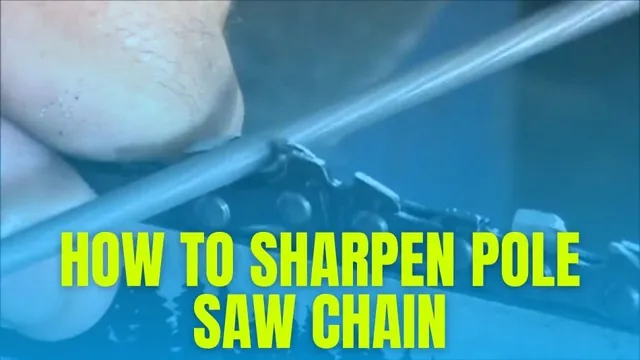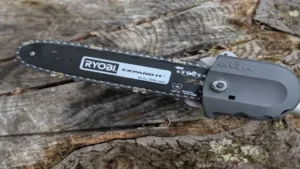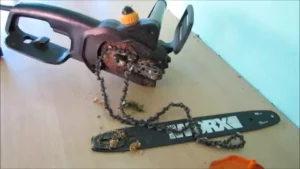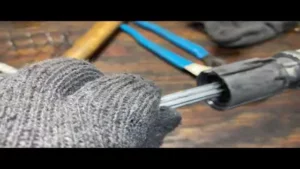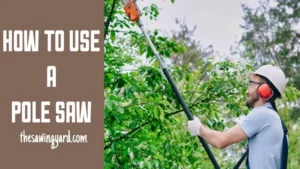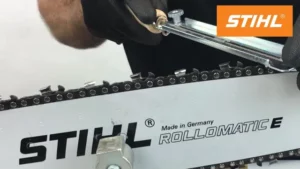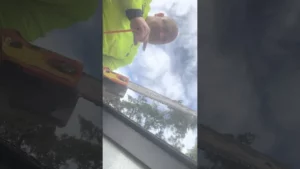Do you own a pole saw and frequently use it for pruning or cutting branches? If yes, then you know how important it is to keep its chain in good condition. The chain is the most crucial part of the pole saw, and any damage to it can make it hard to use. If you find yourself struggling with a pole saw chain that won’t cut through anything, then you’ve come to the right place.
In this blog post, we will guide you through the process of fixing your pole saw chain step-by-step, making it easier for you to get back to your gardening without any hassle. A pole saw chain that is in bad condition can be dangerous to use, as it can snap at any moment while you’re using it. That’s why it’s essential to keep it in good condition and fix any issues as soon as they arise.
By doing so, you can ensure that your pole saw remains in good working condition, and you can be assured of your safety while using it. Once you understand how to repair and maintain your pole saw chain, you can extend its lifespan and keep it in great working condition. We will provide you with tips and tricks to follow, enabling you to get the most out of your pole saw.
Whether you’re a professional gardener or a homeowner with a green thumb, this guide will be helpful to you. So let’s dive in!
Assess the Damage
Fixing a damaged pole saw chain can be a challenge, but the first step is assessing the damage. Look for any visible signs of damage, such as nicks, dents, or bent teeth on the chain. Also check for signs of wear and tear, such as stretched links or cracked rivets.
Once you’ve identified the damage, you can decide what steps to take. Some minor damage can often be fixed with a file or grinder, while more serious damage may require replacing the chain altogether. If you’re not sure how to fix a damaged chain, it’s always best to seek the advice of a professional.
By taking the time to properly assess the damage, you can ensure that your pole saw chain is back in good working order, and ready for your next job.
Inspect the Chain and Bar
When assessing the chain and bar, the first thing to inspect is the overall damage. You’ll want to look for any visible signs of wear and tear, such as cracks, nicks, or dents. These can be indicative of deeper issues that may affect the performance of your chainsaw.
Additionally, check the alignment of the bar to ensure that it’s straight. A bent or warped bar can cause the saw to kick back, leading to potentially dangerous situations. It’s also important to inspect the chain for any worn or damaged teeth.
A damaged chain can cause the saw to cut poorly or even seize up, requiring costly repairs. By taking the time to assess the damage to your chain and bar, you’ll be able to identify any potential issues before they become major problems. This can save you time and money in the long run, as well as keep you safer while using your chainsaw.
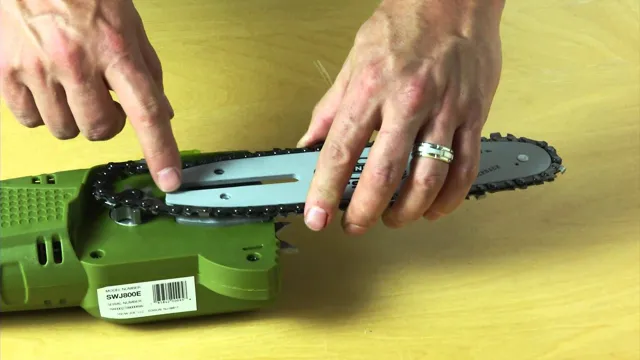
Look for Bent or Damaged Links
When it comes to assessing the damage of bent or damaged links, it’s important to first understand the potential impact they can have on your website’s SEO. Broken links can harm the reputation of your website, negatively impacting your website’s ranking on search engines. Therefore, it’s essential to regularly check your website for any broken or bent links, so you can quickly repair them and avoid any serious damage.
The process of assessing the damage means taking a close and thorough look at all of your website’s links, identifying any that are bent, broken, or entirely missing. Once you’ve successfully identified these links, you can take action to either replace or repair them. Remember, the more accurate and up-to-date your website’s links are, the better your website’s overall performance will be.
So, don’t ignore any potential broken links and take a proactive approach in maintaining your website’s SEO.
Check the Tension of the Chain
When checking the tension of your bike chain, it’s important to assess any damage that may have occurred. A loose or sagging chain can cause a variety of issues, from poor shifting to chain skipping, so it’s crucial to ensure proper tension. Before adjusting the tension, inspect the chain for any signs of wear or damage, such as stretched links or missing teeth.
If you notice any damage, it’s best to replace the chain entirely to prevent further issues down the road. Don’t forget to also check the condition of your chainrings and cassette, as these components work together to create a smooth and efficient drivetrain. By properly assessing the condition of your chain and drivetrain, you can ensure a more enjoyable and safe riding experience.
Remove the Chain
When it comes to fixing a pole saw chain, the first step is to remove the chain from the saw. This might sound daunting, but it’s actually a straightforward process. Start by unplugging the tool and wearing thick gloves to protect your hands.
Next, locate the chain tensioner on the saw and use a wrench to loosen the tension on the chain. Once it is loose, you can remove the chain from the guide bar by sliding it out. Be sure to inspect the chain for any damage or dullness while you have it off.
If there are any issues that need to be addressed, you can take this opportunity to sharpen or replace the chain. Once the chain is prepared, it can be re-installed on the saw by essentially reversing the steps you took to remove it. Tighten the tension on the chain, but be careful not to overtighten it.
Proper tension is key to the saw’s performance and longevity, so take the time to make sure it’s just right.
Secure the Saw and Remove the Bar
When it comes to operating a chainsaw, it’s essential to know how to remove the chain safely. Before you attempt to remove the chain, make sure the saw is secure and the bar is locked in place. Then, with the tool turned off, locate the chain tensioner and use a wrench to loosen the nuts holding the bar in place.
Once the nuts are removed, you can lift the bar up and remove the chain. It’s important to note that chains are sharp and can cause injury if mishandled. Make sure to wear protective gloves and handle the chain with care while removing it.
By following these instructions, you’ll be able to remove the chain safely and with ease.
Take the Chain off the Sprocket
One of the most crucial tasks when it comes to maintaining your bicycle is removing the chain. But, how do you do it? First, shift your gears to the smallest sprocket to loosen the pressure on the chain. Then, use a chain tool to remove the pins from the links of the chain.
This will require some force, so make sure you have a good grip on the tool. Once the pin is out, you can separate the chain from the sprocket teeth. It’s important to remove the chain every once in a while for cleaning and lubrication purposes, as well as to prevent wear and tear on your sprocket and gears.
So, take the opportunity to examine the chain for any damage or fraying while you have it off. By regularly taking the chain off the sprocket, you can ensure a smoother ride and a longer lifespan for your bicycle.
Repair or Replace the Chain
If you’re experiencing problems with your pole saw chain, you may be wondering whether you should try to fix it or just replace it altogether. Luckily, fixing a damaged pole saw chain is a simple process that can be done in just a few steps. First, you need to identify what’s causing the problem with your chain.
This could be anything from a dull blade to a damaged link. Once you’ve diagnosed the issue, you can start the repair process by using a saw file to sharpen the blades or replacing the damaged links. If the problem is too severe, you may need to replace the entire chain.
In any case, it’s important to regularly maintain your pole saw chain to ensure it’s working properly and safely. By taking care of your equipment, you’ll be able to extend the life of your pole saw and save money in the long run. So next time you’re faced with a broken chain, don’t panic – with a little bit of know-how, you can easily fix it yourself.
File or Replace Damaged Links
As a website owner or manager, you must ensure that all links on your site are working properly to offer a seamless user experience. Damaged links, commonly referred to as broken links, can greatly affect your site’s reputation and user experience. To address this issue, it is crucial to repair or replace any damaged links on your site.
One effective way of doing this is by manually checking each link and fixing any errors. You can also use online tools to scan your site and identify broken links. Once identified, you can either repair or replace these links with working ones.
Repairing broken links can be time-consuming, but it ultimately improves your site’s overall health and user experience. Remember that broken links can negatively impact your site’s overall search engine ranking, so it’s critical to repair or replace them as soon as possible.
Purchase a New Chain if Necessary
One of the most critical parts of your bicycle is the chain, which is responsible for transmitting power from your pedals to the wheels. If your bike chain is not in good condition, you’ll experience difficulty shifting gears, and your ride will be less efficient. In some cases, you may be able to repair a damaged chain by replacing a single link or two.
However, if there are numerous damaged links, it may be time to replace the entire chain. In general, it’s a good idea to examine your bike’s chain regularly to detect early signs of wear and tear. If you discover that your chain is excessively stretched, rusted, or kinked, it’s best to replace it with a new one.
A high-quality bike chain can be a wise investment to ensure your cycling experience is smooth, efficient, and safe. By keeping on top of your chain maintenance, you’ll save yourself money in the long run by avoiding further repairs and replacements.
Reinstall the Chain
If you’re wondering how to fix pole saw chain, one common solution is to reinstall the chain. Start by removing the chain cover and loosening the tension adjustment screw, which will allow you to remove the chain. Inspect it carefully for any damage or wear, and replace it if necessary.
Next, thread the new chain onto the saw, making sure that the teeth are facing in the right direction and that the chain is properly seated on the guide bar. Tension the chain by tightening the adjustment screw until there is no slack but still some flexibility in the chain. Finally, test the saw by letting it run for a few seconds to ensure that the chain is properly aligned and turning smoothly.
By following these steps, you should be able to fix your pole saw chain and get back to work cutting branches and trees.
Place the Chain on the Sprocket and Bar
Reinstalling the chain onto your bike’s sprocket and bar can be a bit tricky, but with a little patience and attention to detail, you can have your bike running smoothly again in no time. Begin by aligning the chain with the sprocket teeth and resting it on top. Make sure the chain runs correctly over the derailleur, and that it’s not twisted or crossed before you move on to the next step.
Next, position the bar beneath the chain and guide it up to connect with the sprocket. Engage the teeth of the sprocket with the links of the chain, alternating sides and using a little force to ensure a tight fit. Be sure to check the chain tension by pulling down on the bottom section.
It should have a slight amount of slack, but not too much that it droops. Now that the chain is in place, give it a spin to ensure everything works correctly. With a little practice, installing the chain onto the sprocket and bar is straightforward and easy to do.
Adjust the Chain Tension
After adjusting the chain tension on your bike, it’s time to reinstall the chain. First, place the chain over the rear sprocket and then slide it over the front sprocket. Make sure that the chain has proper engagement with both sprockets.
Next, align the master link with the chain by pulling the chain towards the back of the bike to create enough slack in the chain. Once the master link is aligned with the chain, put the two ends of the master link together by sliding them towards each other. Make sure that the clip is secure and in its place.
Finally, check the chain tension and adjust it if required. A loose or tight chain can lead to safety hazards and can result in poor performance. By following these simple steps, you can ensure that your chain is correctly reinstalled and is in excellent working condition for your next ride.
Final Tips and Safety Precautions
Now that you know how to fix a pole saw chain, it’s important to keep some final tips and safety precautions in mind. First, always wear protective gear such as goggles, gloves, and ear protection when using a pole saw. Additionally, be sure to inspect your pole saw regularly and replace any worn or damaged parts.
Keep your pole saw clean and properly lubricated to ensure the chain runs smoothly. Finally, be aware of your surroundings and make sure to clear the area of any debris or obstacles before you begin to use the saw. With these safety precautions in mind, you’ll be well on your way to safely and effectively using your pole saw.
Lubricate the Chain Before Use
Before using your bike, it’s important to lubricate the chain properly to ensure a smooth ride. Neglecting to do so can cause unnecessary wear and tear on your bike and result in a less enjoyable experience. Lubricating the chain helps prevent rust and corrosion, reduces friction between the chain and other moving parts, and extends the chain’s lifespan.
There are different types of chain lubricants available, so make sure to choose one that is compatible with your bike’s chain. It’s also important to avoid over-lubricating as this can attract dirt and debris, which can cause even more damage. Remember, a well-lubricated chain will not only improve the overall performance of your bike but also keep it in good working condition for years to come.
Wear Proper Safety Gear
Wearing proper safety gear is crucial when engaging in any physical activity that puts you at risk. Whether you’re into skateboarding, rollerblading, or cycling, wearing appropriate gear can reduce the impact of an accident and prevent serious injuries. This includes helmets, knee and elbow pads, wrist guards, and properly fitting shoes.
We cannot stress enough the importance of ensuring the gear you wear is not only comfortable but also meets the recommended safety standards. Before purchasing any safety gear, make sure to do your research and invest in quality gear that will provide adequate protection. Don’t wait until it’s too late to realize the importance of wearing proper safety gear.
Remember, prevention is always better than cure, and your safety should be your top priority.
Conclusion
In conclusion, fixing a pole saw chain is not rocket science. It requires patience, skill, and a solid understanding of how chains work. Just like life, sometimes we need to step back, assess the situation, and make necessary adjustments to keep moving forward.
So next time you find yourself with a broken pole saw chain, don’t panic! Take a deep breath, grab your tools, and get to work. With a little bit of effort, you can enjoy a smooth and efficient sawing experience, one that would rival even the most seasoned lumberjack. After all, as it’s commonly said, a well-maintained chain is a happy chain, and a happy chain is key to a happy life.
So let’s get to fixing, shall we?”
FAQs
What are common reasons for pole saw chain issues?
Some common reasons for pole saw chain issues include dullness, incorrect tension, and improper lubrication.
How do I know if my pole saw chain needs to be replaced?
Signs that your pole saw chain may need to be replaced include excessive wear, missing teeth, or a chain that has become loose.
How do I maintain my pole saw chain?
Regular maintenance of your pole saw chain includes cleaning debris, lubricating the chain, and regularly checking the tension.
What type of lubricant should I use on my pole saw chain?
Use a high-quality, chain-specific lubricant on your pole saw chain for best results.
Can I sharpen my own pole saw chain?
Yes, but it requires specific tools and knowledge. Consider taking a chainsaw sharpening course or having a professional do it for you.
How do I properly tension my pole saw chain?
Refer to your pole saw’s manual for specific instructions, but generally, the chain should be tight enough that you can lift it slightly off the guide bar, but loose enough that you can still move it by hand.
What should I do if my pole saw chain becomes stuck?
Do not try to force it, as this could damage the saw or cause injury. Turn off the saw and carefully remove the chain, then inspect it for any issues before reassembling.
